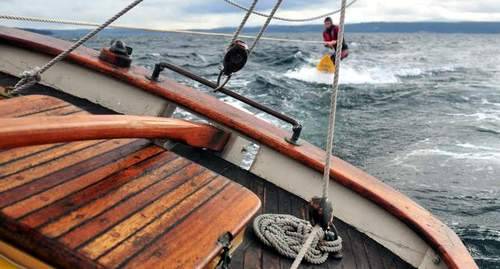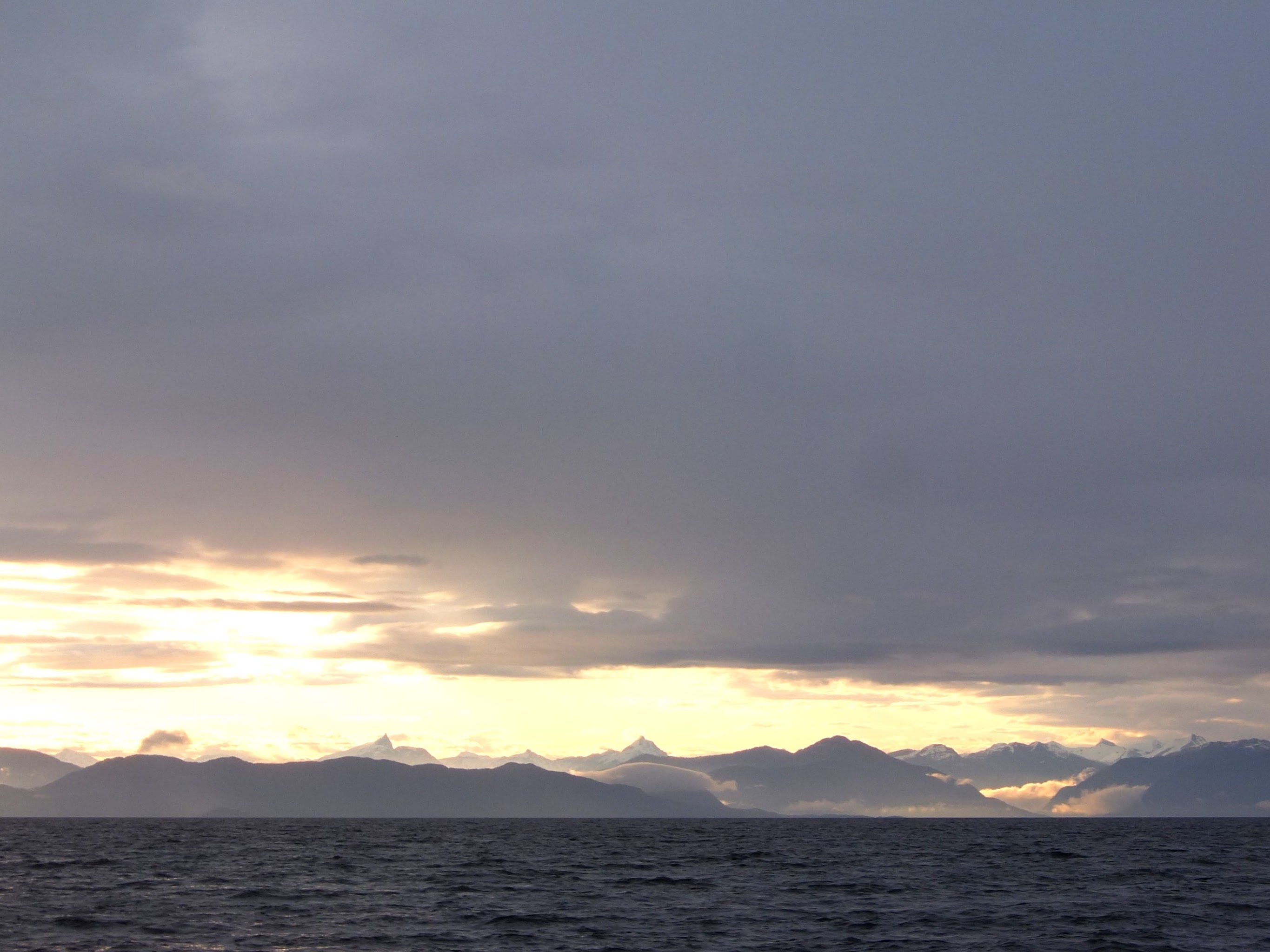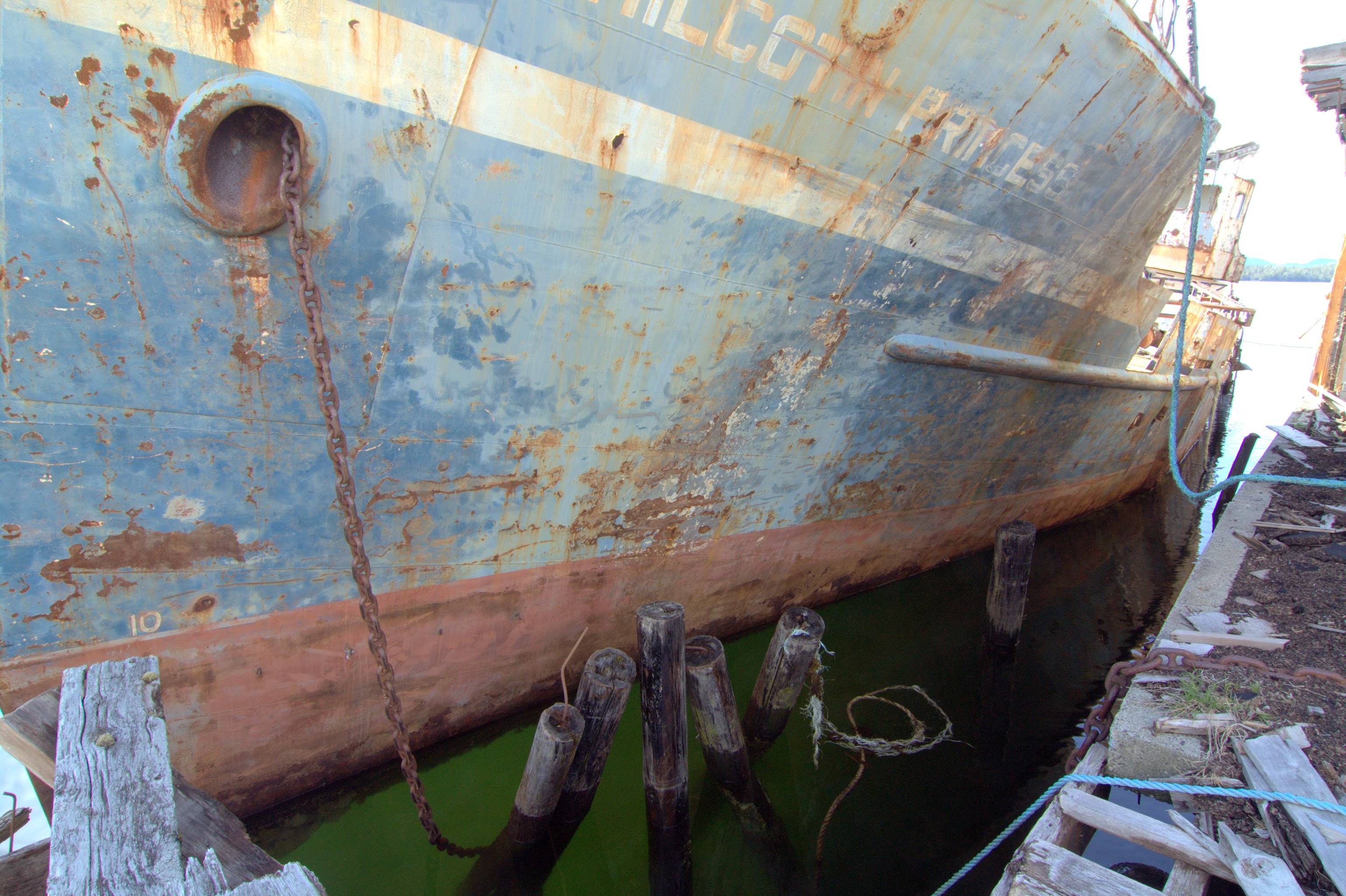Friends recently called me. “The wind is up, we need your help”. One of them was going to try towing the other on his surfboard, behind a 1938 Atkins gaff ketch. They’d be sailing in a lot of wind as fast as possible, across the path of a Washington State ferry (to trust a Washington State ferry captain is to risk your life). With the difficulties of steering, tacking a traditional rig, and keeping the towline in the surfers hands, they figured they’d need me on the boat.
I agreed. Wouldn’t you? People with crazy ideas need us, the willing volunteers.

Photo by Michael Truex
It was a nasty day, rainy, blowing 25 knots. We had the main and genoa up, and we got up over 8 knots. For a boat with a waterline of 30 feet, that’s pretty good. We started slow, so the line wouldn’t snap out of the surfers hands, and soon he was on his knees, plowing through the chop. There were fits and starts, he would fall off the board sometimes, so we had to do a lot of tacking, heading up, and so on. It was a man overboard drill with a difference: rather than getting the man back aboard, we needed to deliver the towline to his waiting hands and then control our speed as the he caught up to us. Sailing a 22,000 pound boat right at your friend as he bobs up and down in the chop really focuses the mind. He got up on his feet once, so I’d say the surfing was a success. And I got one hell of a sailing lesson.
In the early spring of this year, the same friend called me up. He needed help with his seasonal commute. He fishes in Alaska during the summer, works on boats in Port Townsend in the winter, and lives on that gaff ketch year round, changing towns but not homes. The boat doesn’t sail itself, so he asks for help for each trip.
The trip by necessity is always in a season a little earlier or a little later than the comfort loving cruiser would choose. But there are always those who are willing. Unreasonable people, his friends, sailors drawn to his unusual craft, and assorted dreamers. I don’t know how I ended up onboard. I’m a comfort loving cruiser.

The vessel is a pure wooden boat right out of some magazine. It smells like a lumberjack’s wallet. It has an inboard diesel, designed to run at low rpms and make as salty a noise as possible. The decks leak, and to control the leaks you “salt the decks”, pouring salt water over the deck in hopes of swelling the wood and closing the leaks. But that just makes certain that there will be drips down below even if it isn’t raining. The bowsprit could claim your life in calm weather. The staysail is self tacking, which sounds nice, but the only thing it does by itself is attack you when you are trying to untangle things on the fore deck. There are few winches. The halyards and some of the sheets use blocks for the enormous purchase needed to manage the heavy spars. Eight thousand seven hundred and forty two nautical miles of shippy looking laid line run through the various blocks, and will tangle themselves and become tangled with each other even if you are paying attention. And maybe you weren’t paying attention, just that once. There are running backstays, things modern cruisers rarely use, and it is “no big deal really”, but if you do it wrong, the mast might snap in half and fall to the deck.

But its a wonderful boat as well. So I felt a great sense of place and of purpose as we pushed off from the fuel dock in Port Townsend. I was perched on a transom that was shaped at a time when my grandparents had not yet met each other and Adolf was still a popular name. We blasted the old Johnny Horton tune “North to Alaska” and as we left the harbor we were unbearably scenic.
Fortunately, most of the trip up the inside passage is done away from human eyes, so the feeling of self awareness that comes with being unbearably scenic soon passed.
Though we had a diesel engine and plenty of fuel, we sailed as much as possible. And when headed north in the narrow channels of the inside passage, the only wind that is favorable is a south wind. Southeast, southwest, whatever, once it has been blowing up a channel for a while it always comes from the same direction. Where you have been. It turns corners and follows you up.

But south wind means bad weather and it can mean a gale. If the weather was nice, the wind would be from the north, and we’d have to tack back and forth in narrow channels against the head wind. So every morning we’d wake up snug in an anchorage as ask “Is the weather nice? Then let’s stay put. Is it nasty bordering on dangerous? Up anchor, lets go!” We headed out into two forecast gales, neither of which fully materialized, but we sailed in plenty of 20-30 knot winds, all of them carrying cold rain. We made excellent time. Which left time to explore the world we passed through when the weather was nice.

These are my favorite voyages, where land is all around, but its land that is nearly impossible to get to unless you arrive by sea. The places you reach can feel utterly remote, even if they have a store and wi-fi.

Consider Namu. This formerly settled place certainly had no wi-fi, no people at all, but at first glance we couldn’t tell that. Namu is an abandoned cannery, which after being abandoned became a cruising boat destination, but now that destination is also abandoned. Layers upon layers of recent archaeological evidence hints at the lives of people who lived here a hundred years ago, a few decades ago, and last fall. All the letters in the abandoned post office were dated from the early 80s. The well stocked marine store had been ransacked, but still had thousands of diesel fuel filters new in boxes. Probably also from the 80s.

Hungry? Upstairs are pallets loaded with jars of Bulgarian peach jam. The well tended weed free gardens were blooming in the spring sun. They must have been cared for as recently as last fall. We didn’t visit the nearby archaeological dig, but Wikipedia suggests that people have been ditching this place for better lives somewhere else for 10,000 years.

The facilities for the old cannery were enormous. Acre sized warehouses were refrigerated. A diesel power plant held 6 generators the size of buses. Empty tanks (hopefully!) of fish oil and acid loomed several stories tall. A 100+ foot steel tanker lay abandoned, slowly smashing the buildings it was tied to into rubble. It too was unbearably scenic.

Some of the crew went on a night raid of the facilities, facilities that felt haunted in the full sun. At night Namu was super creepy. While they were ashore a ghost stole one of their oars, and they had to slowly scull back to the boat. In the morning, out on the crumbling pier, our intrepid wooden-boat-school-grad captain copied the remaining oar using a nice piece of old growth cedar timber that was lying around. The whole process was unbearably scenic.

Photo by Earth Wandering
Just 35 miles from this pile of iron, diesel filters, archaeology and peach jam you find the town of Shearwater. But to traverse those miles you need a boat, and to have a boat means you brought it with you. From someplace much further away. The people of Shearwater don’t visit Namu much, and were curious to hear news of its condition. Just 35 miles and a world away. In Shearwater there was a store, with a credit card machine, id checks for alcohol, and fresh vegetables, which out there seemed just as strange as anything else.
The wifi cost 10 bucks, maybe more, and I can say without exaggeration that it provided at most 300 bytes per second.

We restocked, filled our water tanks, and pressed on, encountering oddities and strange people daily as we made our way to the US border. On our last night in Canada we could see the border from our anchorage. All around was nothing, land and water that were too remote or stormy to be of use to anyone. And an imaginary line. In the morning we crossed that line and cleared customs in Ketchikan. I got on an Alaskan air flight and then retraced my steps over the last few weeks at several hundred miles per hour.

I got back to Port Townsend right away. Now that fall is here, the boat and it’s captain are back down south as well. On the trip down, the crew had to heave to in a gale off of Haida Gwaii. I’m so glad I wasn’t aboard. Still, if they call me asking for help with some crazy scheme I’ll agree without hesitation. If anything interesting is ever going to happen, we are going to have to do it ourselves. And that means either thinking of it, or agreeing to help out with it.





































































